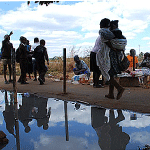
By Lesley Wurayayi AT least 162 people in Harare and Chitungwiza have been treated for suspected typhoid, as Zimbabwe battles a resurgence of the waterborne disease that wreaked havoc late last year. Harare City Council director of health services, Prosper Chonzi said the city recorded more than 100 cases of suspected typhoid by Friday, with most of them testing positive.
“To date over a 100 residents have been treated, 16 are admitted at Beatrice Infectious Diseases Hospital and more are being treated as we speak,” he said. Chonzi said a permanent solution was needed to curb future typhoid outbreaks in the capital and its satellite town, Chitungwiza.
“A permanent solution will be for residents to access potable water every day and avoid erratic water shortages,” he said.
Chonzi, however, was grateful that the latest outbreak was not spreading as fast as last year’s due to a change in weather.
“This time around there is no back sewer, so the disease is not spreading fast, unlike with the rainy season, where there was a lot of back sewer,” he said. Typhoid is a waterborne disease, whose symptoms show between one and three weeks after exposure to its pathogens.
Symptoms include slow progressing fever, reaching as high as 40 degrees celsius, profuse sweating and non-bloody diarrhoea.
Untreated typhoid fever manifests itself through headaches, coughing, no-se-bleeding and abdominal pains.
Community Working Group on Health (CWGH) executive director Itai Rusike urged the council and the ministry to provide residents with potable water as is required by the Public Health Act.
- Chamisa under fire over US$120K donation
- Mavhunga puts DeMbare into Chibuku quarterfinals
- Pension funds bet on Cabora Bassa oilfields
- Councils defy govt fire tender directive
Keep Reading
“The city council and the Ministry of Health should adopt the Public Health Act in full and come up with strategies that will facilitate provision of clean healthy water in future,” he said.
Meanwhile, Harare cou-ncil spokesperson, Leslie Gwindi, has blamed lack of investment in infrastructure for the local authority’s failure to improve water supply.











